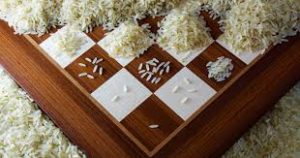Could TROPTIONS be in your future?
Exponential growth is a concept that is inherently hard to grasp for human beings, as we tend to understand the world in a linear fashion. When attempting to explain the concept of exponential growth, the wheat and chessboard problem is often quoted.
While the origins of the problem take on many different variations, the essence of the legend is a chess game between an ancient Indian king and a traveling sage. When the king asked what the sag wanted as a reward if he won, he modestly proposed that he received one grain of rice on the first square of the chessboard, and consequently doubling the number of grains until the 64th square of the board. While this may seem harmless at first, at the end of the chessboard the number of grains would accumulate to 18 quintillion, which is equal to about 210 billion tons and is allegedly sufficient to cover the whole territory of India with a meter thick layer of rice.
When will we learn the lesson?

The number of grains of wheat in the second half of the chessboard is 232 + 233 + 234 + … + 263, for a total of 264 − 232 grains. This is equal to the square of the number of grains on the first half of the board, plus itself. The first square of the second half alone contains more grains than the entire first half. On the 64th square of the chessboard alone there would be 263 = 9,223,372,036,854,775,808 grains, more than two billion times as many as on the first half of the chessboard.
On the entire chessboard there would be 264 − 1 = 18,446,744,073,709,551,615 grains of wheat, weighing about 1,199,000,000,000 metric tons. This is about 1,645 times the global production of wheat in 2014 (729,000,000 metric tons).[8]
Those who think, we’ve reached the second half of the chessboard. I think there is still room to go!
